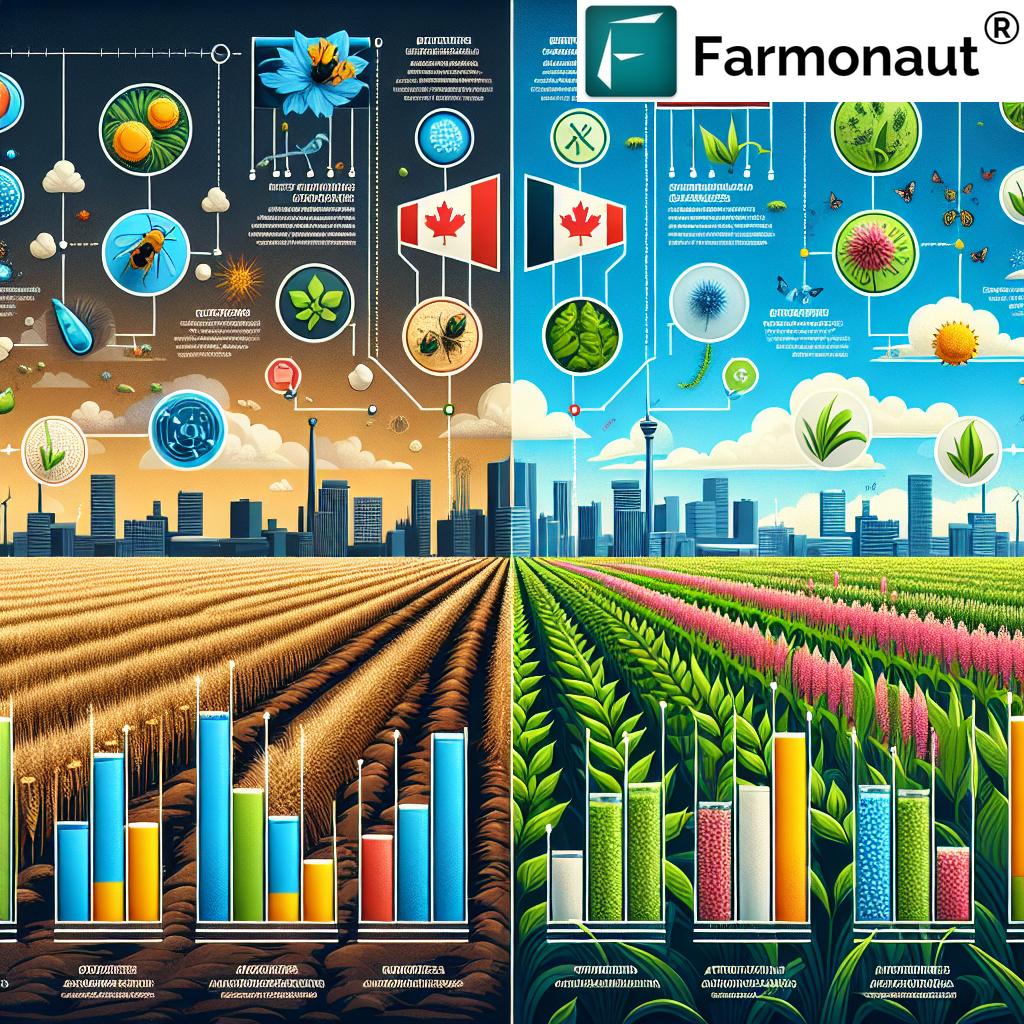Revolutionizing North American Agriculture: The Rise of Sustainable Farming with Microbial Solutions
“The agricultural microbials market is projected to grow from $9.45 billion to $18.75 billion by 2030, nearly doubling in size.”
In the ever-evolving landscape of agriculture, we are witnessing a remarkable transformation that’s set to revolutionize farming practices across North America and beyond. At the heart of this change lies the burgeoning field of agricultural microbials – a sustainable solution that’s redefining how we approach crop production, soil health, and environmental stewardship. As we delve into this exciting topic, we’ll explore the tremendous growth potential of the agricultural microbials market and its far-reaching implications for farmers, consumers, and the planet.
The Boom in Agricultural Microbials: A Market Overview
The agricultural microbials market is on an impressive upward trajectory. Current projections indicate a surge from $9.45 billion in 2025 to a staggering $18.75 billion by 2030. This phenomenal growth, characterized by a compound annual growth rate (CAGR) of 14.7%, underscores the increasing recognition of microbial solutions in modern farming practices.
Several factors are driving this explosive growth:
- Sustainable Farming Practices: There’s a growing demand for eco-friendly agricultural methods that reduce reliance on synthetic chemicals.
- Consumer Preferences: The market is responding to an increasing consumer appetite for organic produce and sustainably grown food.
- Environmental Awareness: Heightened concerns about the environmental impact of traditional farming methods are pushing the industry towards more sustainable alternatives.
- Regulatory Support: Initiatives like the EU’s Farm to Fork Strategy are promoting the use of microbial alternatives, including biopesticides, biofertilizers, and biostimulants.
The Dominance of Bacteria in Agricultural Microbials
“Bacteria dominate the agricultural microbials market, with beneficial strains like Bacillus and Rhizobium leading the charge in sustainable farming.”
Within the realm of agricultural microbials, bacteria reign supreme. Beneficial bacterial strains such as Bacillus, Pseudomonas, and Rhizobium have captured a significant market share due to their versatility and effectiveness in various agricultural applications. These microscopic powerhouses are revolutionizing farming in several ways:
- Enhancing Crop Productivity: Certain bacterial strains can boost nutrient uptake and stimulate plant growth, leading to increased yields.
- Improving Soil Health: Beneficial bacteria play a crucial role in maintaining soil structure, fertility, and microbial diversity.
- Boosting Nutrient Availability: Some bacteria can fix atmospheric nitrogen or solubilize phosphorus, making these essential nutrients more accessible to plants.
- Pest and Disease Management: Many bacterial strains exhibit biopesticidal properties, offering natural protection against plant pathogens and pests.
The adaptability of these bacterial strains to various environmental conditions has made them an indispensable tool in the pursuit of sustainable agriculture. As we continue to uncover the potential of these microscopic allies, their role in shaping the future of farming becomes increasingly evident.

Soil Amendments: The Foundation of Microbial Agriculture
In the realm of agricultural microbials, soil amendments play a pivotal role. These microbial-based products are crucial for enhancing soil health and fertility, addressing the growing concern of soil degradation and the need to reduce chemical inputs. Here’s how microbial soil amendments are making a difference:
- Nutrient Availability: Microbial amendments can unlock nutrients that are otherwise unavailable to plants, improving overall soil fertility.
- Soil Structure: Certain microbes help improve soil structure, enhancing water retention and reducing erosion.
- Organic Matter Decomposition: Microbial activity accelerates the breakdown of organic matter, enriching the soil with valuable nutrients.
- Plant-Microbe Symbiosis: Many soil amendments foster beneficial relationships between plants and microorganisms, leading to improved plant health and resilience.
The growing focus on soil health management has propelled the soil amendment segment to a significant position within the agricultural microbials market. As farmers and agronomists recognize the long-term benefits of healthy soils, the demand for these innovative products continues to rise.
North America: Leading the Microbial Revolution
When it comes to the adoption of agricultural microbials, North America stands at the forefront. The region’s dominance in this market can be attributed to several factors:
- Advanced Agricultural Practices: North American farmers are quick to embrace innovative solutions that promise improved yields and sustainability.
- Robust Research and Development: Substantial investments in R&D have led to the development of cutting-edge microbial products tailored to regional needs.
- Strong Consumer Demand: North American consumers are increasingly seeking organic, chemical-free produce, driving the adoption of microbial solutions.
- Supportive Regulatory Environment: Government initiatives promoting soil health and environmental conservation have created a favorable climate for microbial products.
Both the United States and Canada are leading the charge in adopting microbial products to enhance agricultural productivity while minimizing the use of synthetic chemicals. The established agricultural infrastructure in these countries, coupled with a strong emphasis on innovation, has created an ideal ecosystem for the growth of the agricultural microbials market.
To get a clearer picture of the market growth across different regions, let’s take a look at this comparative table:
| Region | Market Value 2023 (Estimated) | Projected Market Value 2030 | Compound Annual Growth Rate (CAGR) |
|---|---|---|---|
| North America | $3.5 billion | $7.8 billion | 15.2% |
| Europe | $2.8 billion | $5.9 billion | 13.8% |
| Asia-Pacific | $2.2 billion | $4.1 billion | 14.5% |
| Rest of World | $0.95 billion | $0.95 billion | 13.2% |
As we can see, North America is projected to maintain its leadership position, with the highest CAGR and the largest market share by 2030.
The Role of Technology in Microbial Agriculture
As the agricultural microbials market expands, technology plays an increasingly crucial role in optimizing the application and effectiveness of these products. One such technological advancement comes from Farmonaut, a company at the forefront of precision agriculture.
Farmonaut’s satellite-based crop monitoring system complements the use of microbial solutions by providing farmers with precise data for optimized applications. Here’s how Farmonaut’s technology can enhance the use of agricultural microbials:
- Targeted Application: Satellite imagery can help identify areas of the field that may benefit most from microbial treatments, allowing for more efficient use of resources.
- Monitoring Effectiveness: By tracking crop health over time, farmers can assess the impact of microbial applications and adjust their strategies accordingly.
- Soil Moisture Management: Accurate soil moisture data can help farmers create optimal conditions for microbial activity in the soil.
- Integration with AI: Farmonaut’s AI-driven advisory system can provide recommendations on when and where to apply microbial products for maximum benefit.
To learn more about how Farmonaut’s technology can complement your microbial agriculture practices, visit their web application or download their mobile apps:
The Environmental Impact of Microbial Solutions
One of the most compelling aspects of the agricultural microbials market is its potential to address pressing environmental concerns. As we face the challenges of climate change and resource depletion, microbial solutions offer a pathway to more sustainable farming practices. Here’s how:
- Reduced Chemical Use: By replacing or supplementing synthetic fertilizers and pesticides, microbial products help decrease the environmental impact of agriculture.
- Improved Soil Health: Healthy soils, fostered by microbial activity, can sequester more carbon, contributing to climate change mitigation.
- Water Conservation: Many microbial products improve soil structure and water retention, leading to more efficient water use in agriculture.
- Biodiversity Preservation: By promoting a more balanced approach to pest and disease management, microbial solutions help preserve beneficial insects and soil organisms.
The growing adoption of these environmentally friendly practices aligns with global sustainability goals and represents a significant step towards a more resilient and eco-friendly agricultural system.
The Future of Microbial Agriculture
As we look to the future, the potential of microbial agriculture seems boundless. Ongoing research and development in this field are uncovering new applications and refining existing products. Some exciting areas of development include:
- Customized Microbial Consortia: Tailored combinations of microorganisms designed for specific crops or growing conditions.
- Nanotechnology Integration: Using nanotechnology to improve the delivery and efficacy of microbial products.
- Climate-Resilient Strains: Developing microbial strains that can help crops withstand extreme weather conditions.
- Microbial Seed Coatings: Enhancing seed performance through microbial treatments applied directly to seeds.
These advancements, coupled with increasing awareness and adoption, paint a promising picture for the future of sustainable agriculture.

Challenges and Opportunities
While the future of agricultural microbials is bright, there are challenges to overcome:
- Education and Awareness: Many farmers are still unfamiliar with microbial products and their benefits.
- Regulatory Hurdles: The approval process for new microbial products can be lengthy and complex.
- Consistency and Efficacy: Ensuring consistent performance across various environmental conditions remains a challenge.
- Integration with Existing Practices: Helping farmers seamlessly incorporate microbial solutions into their current farming systems.
However, these challenges also present opportunities for innovation and growth within the industry. Companies that can address these issues effectively will be well-positioned to capture a significant share of this expanding market.
Embracing the Microbial Revolution: A Call to Action
As we stand on the brink of this agricultural revolution, it’s clear that microbial solutions have the potential to transform farming as we know it. For farmers, agronomists, and agricultural businesses, now is the time to explore and invest in these innovative technologies.
Here are some steps you can take to be part of this exciting transformation:
- Educate Yourself: Stay informed about the latest developments in agricultural microbials through industry publications, webinars, and conferences.
- Trial Programs: Consider participating in trial programs to test microbial products on your farm or in your operations.
- Collaborate: Connect with researchers, extension services, and other farmers to share experiences and best practices.
- Integrate Technology: Explore how precision agriculture tools, like those offered by Farmonaut, can enhance your use of microbial products.
- Think Long-term: Remember that the benefits of microbial solutions often compound over time, contributing to long-term soil health and sustainability.
By embracing these sustainable farming practices, we can work together to create a more resilient, productive, and environmentally friendly agricultural system.
Farmonaut: Your Partner in Precision Agriculture
As we navigate this new era of sustainable farming, tools that provide accurate, real-time data become invaluable. Farmonaut’s satellite-based farm management solutions offer a perfect complement to microbial agriculture practices. By providing detailed insights into crop health, soil moisture, and other critical metrics, Farmonaut enables farmers to optimize their use of microbial products and maximize their benefits.
To explore how Farmonaut can support your journey towards more sustainable and efficient farming, visit their web application or check out their API services:
- Farmonaut API: Integrate powerful satellite and weather data into your own systems.
- API Developer Docs: Comprehensive documentation to help you get started with Farmonaut’s API.
Earn With Farmonaut: Join our Affiliate Program
Earn 20% recurring commission with Farmonaut’s affiliate program by sharing your promo code and helping farmers save 10%. Onboard 10 Elite farmers monthly to earn a minimum of $148,000 annually—start now and grow your income!
Farmonaut Subscriptions
Frequently Asked Questions
Q: What are agricultural microbials?
A: Agricultural microbials are beneficial microorganisms, such as bacteria, fungi, and viruses, used to enhance crop productivity, improve soil health, and manage pests and diseases in agriculture.
Q: How do microbial products benefit farmers?
A: Microbial products can increase crop yields, improve nutrient uptake, enhance soil health, provide natural pest control, and reduce the need for synthetic chemicals, leading to more sustainable and cost-effective farming practices.
Q: Are microbial products safe for the environment?
A: Yes, when used correctly, microbial products are generally considered environmentally friendly. They can reduce the need for synthetic chemicals and contribute to improved soil health and biodiversity.
Q: How can I incorporate microbial solutions into my farming practices?
A: Start by consulting with agricultural experts or extension services. Consider conducting small-scale trials on your farm and gradually integrating microbial products into your existing practices. Tools like Farmonaut can help you monitor the effectiveness of these products.
Q: What role does technology play in microbial agriculture?
A: Technology, such as satellite-based monitoring systems and AI-driven advisory tools, can help optimize the application of microbial products, monitor their effectiveness, and provide valuable insights for decision-making in farming operations.
Conclusion
The rise of sustainable farming with microbial solutions represents a pivotal moment in the evolution of agriculture. As we’ve explored throughout this article, the growing adoption of agricultural microbials offers a path to more productive, resilient, and environmentally friendly farming practices. The projected growth of the market from $9.45 billion to $18.75 billion by 2030 underscores the tremendous potential and increasing recognition of these innovative solutions.
North America’s leadership in this field, driven by advanced agricultural practices, strong consumer demand for organic produce, and supportive regulatory environments, sets a powerful example for the global agricultural community. The dominance of bacterial products, particularly beneficial strains like Bacillus and Rhizobium, highlights the effectiveness and versatility of these microscopic allies in enhancing crop productivity and soil health.
As we look to the future, the integration of microbial solutions with cutting-edge technologies, such as Farmonaut’s satellite-based crop monitoring systems, promises to further revolutionize farming practices. These technological advancements will enable more precise, efficient, and effective use of microbial products, maximizing their benefits while minimizing environmental impact.
The shift towards sustainable farming with microbial solutions is not just a trend—it’s a necessary evolution in agriculture that addresses the pressing needs of our time. By embracing these innovations, we can work towards a future where agriculture not only meets the world’s growing food demands but does so in a way that preserves and enhances our planet’s precious ecosystems.
As we continue to unlock the potential of microbial solutions and integrate them with advanced technologies, the future of agriculture looks brighter, more sustainable, and more resilient than ever before. The revolution in North American agriculture is well underway, and its impacts will be felt far beyond the borders of the continent, inspiring a global movement towards more sustainable farming practices.






